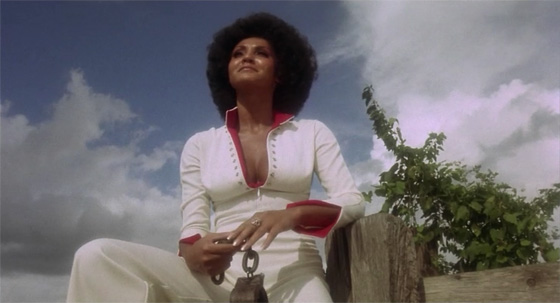 Mob boss Mr. Morgan (Robert Quarry, Count Yorga, Vampire) wants to buy the Club Haiti, a groovy joint with live voodoo acts every night. But owner Langston (Larry D. Johnson) won’t sell, so Morgan’s thugs beat him to death one night in the club parking lot. Langston’s fiancee, Diana “Sugar” Hill (Marki Bey), enlists her police detective ex-boyfriend, Valentine (Richard Lawson, Scream Blacula Scream), to investigate the crime. “You know, if I knew who they were, I would fix it so one by one I could see them die…slowly,” Sugar Hill vows. The very next scene, she’s visiting a spooky old house where she encounters Mama Maitresse (Zara Cully), a white-haired old woman who chides her: “You have always been a nonbeliever. Why do you come to me now?” “Because I want revenge!” Sugar Hill declares…and so the ceremony begins.
Mob boss Mr. Morgan (Robert Quarry, Count Yorga, Vampire) wants to buy the Club Haiti, a groovy joint with live voodoo acts every night. But owner Langston (Larry D. Johnson) won’t sell, so Morgan’s thugs beat him to death one night in the club parking lot. Langston’s fiancee, Diana “Sugar” Hill (Marki Bey), enlists her police detective ex-boyfriend, Valentine (Richard Lawson, Scream Blacula Scream), to investigate the crime. “You know, if I knew who they were, I would fix it so one by one I could see them die…slowly,” Sugar Hill vows. The very next scene, she’s visiting a spooky old house where she encounters Mama Maitresse (Zara Cully), a white-haired old woman who chides her: “You have always been a nonbeliever. Why do you come to me now?” “Because I want revenge!” Sugar Hill declares…and so the ceremony begins.
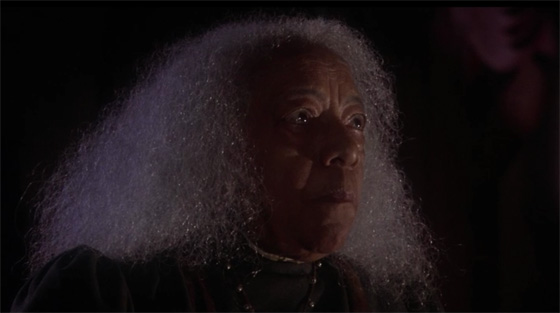 Mama Maitresse leads Sugar Hill into the swamps, amongst stock footage of alligators and snakes, as a smoke machine chokingly fills the screen. Deep in the woods she summons Baron Samedi (Don Pedro Colley, THX-1138), the voodoo god of the dead. (You’ve seen Live and Let Die, right? Same guy.) In sunglasses and a top hat, with a bone earring and wielding a smart-looking cane, he immediately cops an attitude, albeit with an ominous elongation of vowels: “Woman, who are you? I am Baron Samedi. This is my domaaaain. A kingdom of the deeeead!” Hastily Sugar Hill promises her soul in exchange for a few zombies, but Samedi scoffs: “What’s this talk about souls, woman? Ain’t souls I’m interested in.” We never do learn what he’s interested in, though he does have a few zombie brides who hang out at his side, so that might be a clue. He hands over the zombies (“Put them to evil use – it’s all they know or want”), and Sugar Hill sets to work dispatching her enemies.
Mama Maitresse leads Sugar Hill into the swamps, amongst stock footage of alligators and snakes, as a smoke machine chokingly fills the screen. Deep in the woods she summons Baron Samedi (Don Pedro Colley, THX-1138), the voodoo god of the dead. (You’ve seen Live and Let Die, right? Same guy.) In sunglasses and a top hat, with a bone earring and wielding a smart-looking cane, he immediately cops an attitude, albeit with an ominous elongation of vowels: “Woman, who are you? I am Baron Samedi. This is my domaaaain. A kingdom of the deeeead!” Hastily Sugar Hill promises her soul in exchange for a few zombies, but Samedi scoffs: “What’s this talk about souls, woman? Ain’t souls I’m interested in.” We never do learn what he’s interested in, though he does have a few zombie brides who hang out at his side, so that might be a clue. He hands over the zombies (“Put them to evil use – it’s all they know or want”), and Sugar Hill sets to work dispatching her enemies.
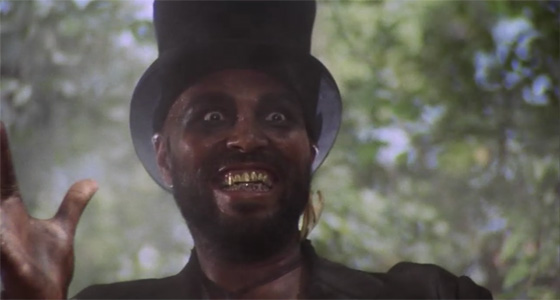 The American International/Samuel Arkoff production Sugar Hill – the only film directed by Paul Maslansky, producer of the Police Academy films – has only the vaguest dressings of a blaxploitation product. It is, by definition, but its heart doesn’t seem in it. Take this pretty representative scene, as Sugar Hill confidently sics her zombies on her first victim. Is this really about revenge against the White Man, or just an expression of deep-seated love for monster movies and spooky makeup? I don’t quite buy the line, “I’m not accusin’ you, HONK.” But at least everyone seems to be having fun.
The American International/Samuel Arkoff production Sugar Hill – the only film directed by Paul Maslansky, producer of the Police Academy films – has only the vaguest dressings of a blaxploitation product. It is, by definition, but its heart doesn’t seem in it. Take this pretty representative scene, as Sugar Hill confidently sics her zombies on her first victim. Is this really about revenge against the White Man, or just an expression of deep-seated love for monster movies and spooky makeup? I don’t quite buy the line, “I’m not accusin’ you, HONK.” But at least everyone seems to be having fun.
Sugar Hill is less inspired by Super Fly (1972) than Plague of the Zombies, the 1966 Hammer horror classic which featured some zombie assassins with equally eerie eyes. It also owes its allegiance to Famous Monsters of Filmland, Warren magazines like Vampirella, and Marvel monster comics such as Tales of the Zombie (1973-1975) and Tomb of Dracula (1972-1979), not to mention other AIP drive-in horrorshows like Count Yorga and Blacula (1972). The early 70’s didn’t produce many classic monster movies – rather, The Exorcist (1973) and The Texas Chain Saw Massacre (1974) were ushering in a more modern, grim-faced, horror film – but it certainly saw a surge of monster fandom. Sugar Hill is aimed at those so-called “monster kids,” so they could persuade their parents to take them to the drive-in, and talk the next day about how cool the zombies looked.
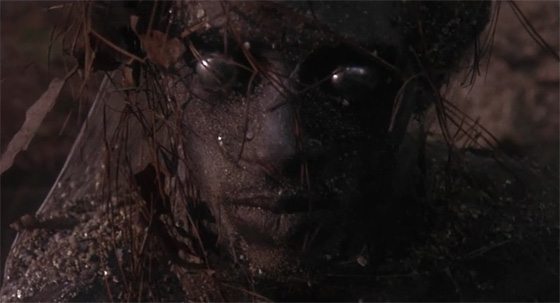 Therefore it shouldn’t be too surprising that the story is construction-paper thin, and as a film it’s pretty disposable. With a ho-hum subplot about Valentine trying to uncover who’s behind all these murders, and Robert Quarry getting mildly agitated as his minions are snuffed one by one, it gets to be repetitive pretty quickly. The climax, rather than offering any complications, simply wraps up the revenge killings and cuts back to that funky theme song, “Supernatural Voodoo Woman.”
Therefore it shouldn’t be too surprising that the story is construction-paper thin, and as a film it’s pretty disposable. With a ho-hum subplot about Valentine trying to uncover who’s behind all these murders, and Robert Quarry getting mildly agitated as his minions are snuffed one by one, it gets to be repetitive pretty quickly. The climax, rather than offering any complications, simply wraps up the revenge killings and cuts back to that funky theme song, “Supernatural Voodoo Woman.”
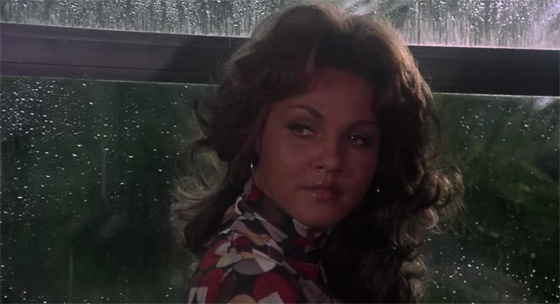 On the positive side, Marki Bey is fetching, though Pam Grier could probably deliver the role with a bit more venom. The zombies, yes, do look pretty cool, despite the bizarre decision to drape them in cobwebs and to paint ripped abs onto their stomachs. Frankly, I’m always partial to a zombie film that’s rooted in Haitian folklore rather than George Romero, especially since pop culture is currently oversaturated with the latter. There’s also a novelty factor which takes Sugar Hill a certain distance – but only so far.
On the positive side, Marki Bey is fetching, though Pam Grier could probably deliver the role with a bit more venom. The zombies, yes, do look pretty cool, despite the bizarre decision to drape them in cobwebs and to paint ripped abs onto their stomachs. Frankly, I’m always partial to a zombie film that’s rooted in Haitian folklore rather than George Romero, especially since pop culture is currently oversaturated with the latter. There’s also a novelty factor which takes Sugar Hill a certain distance – but only so far.
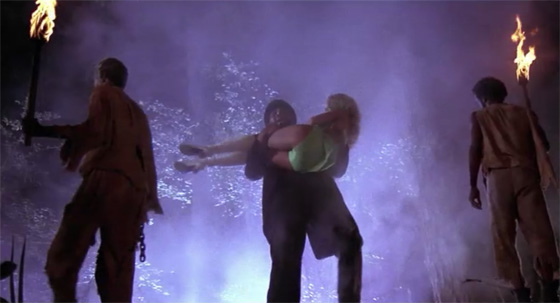 The problem is that the film was made with such modest expectations that no one – not Maslansky, nor the screenwriter, Tim Kelly (Cry of the Banshee) – puts any great effort into making this drive-in fare something special. After the first couple of zombie killings, the film gets pretty dull; though one might be mildly diverted by a death-by-animate-chicken-leg. In the rich tradition of voodoo cinema, from White Zombie (1932) through I Walked with a Zombie (1943), and even The Serpent and the Rainbow (1988), there’s little reason to remember Sugar Hill. Check out some 1970’s Brother Voodoo comics instead. Seriously – he’s a Marvel superhero with voodoo powers. Why didn’t AIP buy the rights?
The problem is that the film was made with such modest expectations that no one – not Maslansky, nor the screenwriter, Tim Kelly (Cry of the Banshee) – puts any great effort into making this drive-in fare something special. After the first couple of zombie killings, the film gets pretty dull; though one might be mildly diverted by a death-by-animate-chicken-leg. In the rich tradition of voodoo cinema, from White Zombie (1932) through I Walked with a Zombie (1943), and even The Serpent and the Rainbow (1988), there’s little reason to remember Sugar Hill. Check out some 1970’s Brother Voodoo comics instead. Seriously – he’s a Marvel superhero with voodoo powers. Why didn’t AIP buy the rights?









